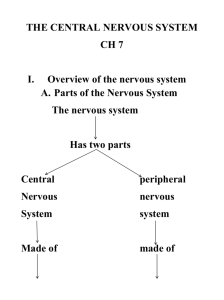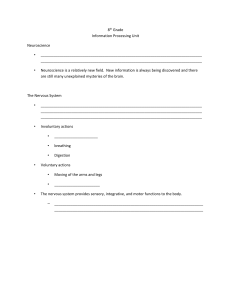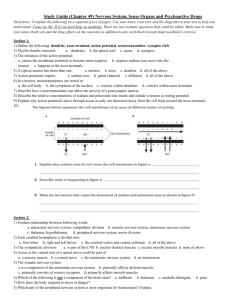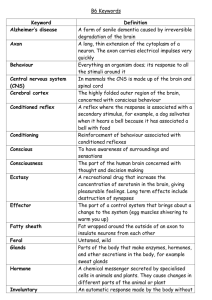neurobiological basis of behavior
advertisement
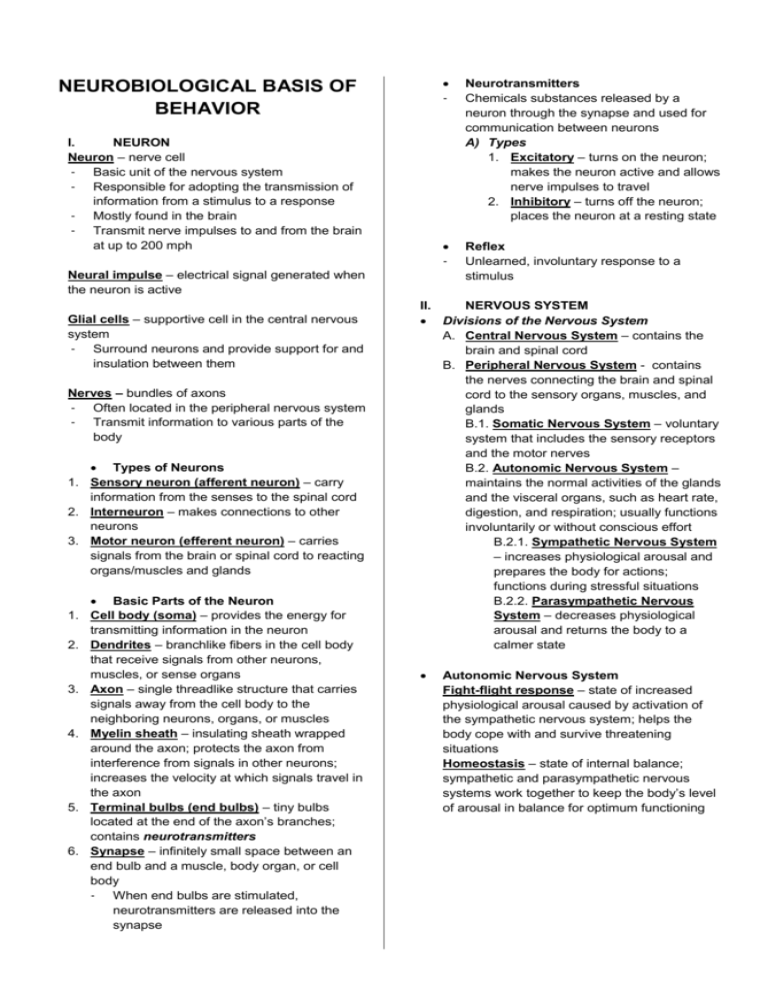
NEUROBIOLOGICAL BASIS OF BEHAVIOR I. NEURON Neuron – nerve cell - Basic unit of the nervous system - Responsible for adopting the transmission of information from a stimulus to a response - Mostly found in the brain - Transmit nerve impulses to and from the brain at up to 200 mph Neural impulse – electrical signal generated when the neuron is active Glial cells – supportive cell in the central nervous system - Surround neurons and provide support for and insulation between them Nerves – bundles of axons - Often located in the peripheral nervous system - Transmit information to various parts of the body Types of Neurons 1. Sensory neuron (afferent neuron) – carry information from the senses to the spinal cord 2. Interneuron – makes connections to other neurons 3. Motor neuron (efferent neuron) – carries signals from the brain or spinal cord to reacting organs/muscles and glands Basic Parts of the Neuron 1. Cell body (soma) – provides the energy for transmitting information in the neuron 2. Dendrites – branchlike fibers in the cell body that receive signals from other neurons, muscles, or sense organs 3. Axon – single threadlike structure that carries signals away from the cell body to the neighboring neurons, organs, or muscles 4. Myelin sheath – insulating sheath wrapped around the axon; protects the axon from interference from signals in other neurons; increases the velocity at which signals travel in the axon 5. Terminal bulbs (end bulbs) – tiny bulbs located at the end of the axon’s branches; contains neurotransmitters 6. Synapse – infinitely small space between an end bulb and a muscle, body organ, or cell body - When end bulbs are stimulated, neurotransmitters are released into the synapse - Neurotransmitters Chemicals substances released by a neuron through the synapse and used for communication between neurons A) Types 1. Excitatory – turns on the neuron; makes the neuron active and allows nerve impulses to travel 2. Inhibitory – turns off the neuron; places the neuron at a resting state - Reflex Unlearned, involuntary response to a stimulus II. NERVOUS SYSTEM Divisions of the Nervous System A. Central Nervous System – contains the brain and spinal cord B. Peripheral Nervous System - contains the nerves connecting the brain and spinal cord to the sensory organs, muscles, and glands B.1. Somatic Nervous System – voluntary system that includes the sensory receptors and the motor nerves B.2. Autonomic Nervous System – maintains the normal activities of the glands and the visceral organs, such as heart rate, digestion, and respiration; usually functions involuntarily or without conscious effort B.2.1. Sympathetic Nervous System – increases physiological arousal and prepares the body for actions; functions during stressful situations B.2.2. Parasympathetic Nervous System – decreases physiological arousal and returns the body to a calmer state Autonomic Nervous System Fight-flight response – state of increased physiological arousal caused by activation of the sympathetic nervous system; helps the body cope with and survive threatening situations Homeostasis – state of internal balance; sympathetic and parasympathetic nervous systems work together to keep the body’s level of arousal in balance for optimum functioning III. THE BRAIN Parts of the Brain A. Forebrain – largest part of the brain A1. Hemispheres: 1. Left Hemisphere – verbal, mathematical, and analytic thinking 2. Right Hemisphere – spatial, holistic, and creative thinking A2. Parts of the Forebrain: 1. Cerebral Cortex – wrinkled surface of the cerebrum 2. Cerebellum - center of thinking and language; controls voluntary actions 3. Corpus Callosum - serves as a bridge between the two hemispheres B. Midbrain – has a reward or pleasure center; has areas for visual and auditory reflexes 1. Reticular activating system (RAS) – Involved in stereotypical behavior, such as attention, walking, sleep, and arousal; arouses the forebrain so that it is ready to process information from the senses C. Hindbrain – consists of the pons, the medulla, and the cerebellum 1. Pons – interconnects messages between the spinal cord and the brain; regulates sleep 2. Medulla – regulates vital bodily processes, such as respiration, heart rate, blood pressure, and some reflexes 3. Cerebellum – controls bodily balance and maintains smooth, coordinated motor movements Cerebral Cortex A) Lobes of the Cerebral Cortex 1. Frontal Lobe – involved in interpreting emotions and experiences, maintaining a healthy personality, performing voluntary movements, paying attention, making decisions, and carrying out plans 2. Parietal Lobe – processes sensory information from body parts, such as touch, pain, heat, visual perception 3. Occipital Lobe – processes visual information 4. Temporal Lobe – involved in hearing, speaking coherently, and understanding oral and written language Limbic System - Group of structures that make up the core of the forebrain; involved in regulating many motivational behaviors, organizing emotional behaviors, and storing memories A) Parts 1. Hypothalamus – regulates motivational behaviors (eating, drinking, sexual behavior), emotional behaviors, and the secretion of hormones - Controls the autonomic nervous system and much of the endocrine system 2. Amygdala – evaluates the emotional significance of stimuli and facial expressions 3. Thalamus – receives sensory information, processes it, and relays it to areas of the cortex 4. Hippocampus – saves many kinds of fleeting memories as long-term memories Endocrine System - Body system made up of numerous glands that secrete various hormones







